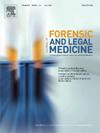Facial growth parameters in Down syndrome: Review of the literature and forensic application for missing persons age progression
IF 1.2
4区 医学
Q3 MEDICINE, LEGAL
引用次数: 0
Abstract
Purpose
Individuals with Down syndrome (DS) show growth trajectories which deviate from standard ones due to variations in the growth of facial structures. Studying the effect of aging on the faces of DS individuals is necessary to obtain an accurate result through age progression, a technique based on the study of physiognomic features and used in cases of missing persons. Here we present scientific publications that delve into the rhythms of aging and morphological characteristics of facial features in DS individuals to enable appropriate age progression in cases of missing DS individuals.
Results
The scientific literature considered in this review studies the growth of soft tissue and bone substrate by comparing standard growth values with those measured through anthropometric measurements of individuals with DS. Growth trajectories are described by considering morphological trends both by comparing standard values with those found in individuals with DS and by observing individual physiognomic traits.
Conclusions
When a young individual with DS goes missing, the realization of an age progression requires knowledge of the aging dynamics peculiar to the DS face. Therefore, physical, cognitive, and clinical factors must be considered. Delayed physical development and early aging, such as the onset of puberty and weight gain, have an important impact on the realization of age progression. In fact, depending on the life period to be considered, the effects of aging must be calibrated based on the knowledge gathered from scientific research.
唐氏综合征的面部发育参数:文献综述与失踪人员年龄进展的法医应用
目的 唐氏综合症(DS)患者由于面部结构的生长变化,其生长轨迹与标准轨迹存在偏差。研究衰老对唐氏综合症患者面部的影响对于通过年龄进展获得准确结果是非常必要的,年龄进展是一种基于相貌特征研究的技术,被用于失踪人员案件中。结果本综述中的科学文献通过比较标准生长值和 DS 患者的人体测量值,研究了软组织和骨骼基质的生长。通过将标准值与 DS 患者的标准值进行比较,并通过观察个体的相貌特征,考虑形态学趋势,对生长轨迹进行了描述。因此,必须考虑身体、认知和临床因素。身体发育延迟和早期衰老,如青春期开始和体重增加,对实现年龄进展有重要影响。事实上,根据所考虑的生命周期,必须根据从科学研究中收集的知识来校准衰老的影响。
本文章由计算机程序翻译,如有差异,请以英文原文为准。
求助全文
约1分钟内获得全文
求助全文
来源期刊

Journal of forensic and legal medicine
MEDICINE, LEGAL-
CiteScore
2.70
自引率
6.70%
发文量
106
审稿时长
57 days
期刊介绍:
The Journal of Forensic and Legal Medicine publishes topical articles on aspects of forensic and legal medicine. Specifically the Journal supports research that explores the medical principles of care and forensic assessment of individuals, whether adult or child, in contact with the judicial system. It is a fully peer-review hybrid journal with a broad international perspective.
The Journal accepts submissions of original research, review articles, and pertinent case studies, editorials, and commentaries in relevant areas of Forensic and Legal Medicine, Context of Practice, and Education and Training.
The Journal adheres to strict publication ethical guidelines, and actively supports a culture of inclusive and representative publication.
 求助内容:
求助内容: 应助结果提醒方式:
应助结果提醒方式:


